#aquatic animal facts
Note
Paper Nautilus? Those boys are lovely and I feel like they're SO underrated


Daily Cephalopod #6
These are Argonauts! (Also nicknamed The Paper Nautilus)
To spread some Argonaut love, here's some cool facts!
The females grow much larger than males (about 8 times larger) and they produce a thin eggcase, or their "shell"
Females can mate and reproduce multiple times in their life, while the males only mate once and die shortly after
The males mate by removing their hectocotyl arm, which is then stored in the females eggcase!
The hectocotylus is the modified tentacle on male cepholpods that is used for mating and it was first discovered on an argonaut! (although it was originally misidentified as a parasitic worm attached to the mantle of the female it was discovered on)
The nickname 'Paper Nautilus' is quite misleading, because Argonauts are actually octopuses!
Argonauts have often been observed floating with/on salps, jellyfish, plant debris, driftwood, and even other argonauts at all stages of life!
Argonauts do not reside near the sea floor, they tend to drift closer to the surface and are the only known pelagic octopus!
Like many other octopuses, they have ink, they can change color, and they have venom!
#so yeah!#theyre very cool boys#octopus#argonaut#the argonaut#or the paper nautilus#cephalopod#daily cephalopod#marine life#ocean creatures#ocean critters#marine creatures#marine animals#marine biology#marine facts#sea creatures#sea life#aquatic#aquatic animals#aquatic animal facts#cephalopods#cephalopod facts#octopus facts#ocean animals#ocean life#biology#zoology#animals#squid mail くコ:彡#GOOBERS!!!
254 notes
·
View notes
Text
earth fact time. this is NOT A DRILL! two great white sharks have become best friends!! their names are simon and jekyll and they've travelled together for over 4,000 miles. this is a huge discovery, because great white sharks are usually solitary creatures!
an important note is that these sharks aren't swimming side by side, and are usually a couple kilometres off from each other - but their trackers kept pinging in the same part of the ocean at the same time. scientists think they might be brothers, or following a previously unknown migratory path.
business insider | cbc
(edited 08/10/23 to fix spelling of jekyll's name)
#aquatic#earthposting#facts!#biology#marine biology#marine life#zoology#sea life#sea animals#marine animals#fish#fishblr#sharks#great white shark#earth fact no. 16#simon and jekyll
4K notes
·
View notes
Text
It's big, it's strong, its scaly, it's this week's Wet Beast Wednesday topic! An arapaima, also known as a pirarucu or paiche, is any of four species of fish in the genus Arapaima in the order of bony-tongued fish. There is som ongoing debate about the classification of the species, so to keep thing simple, I'm going to use the most common species names of Arapaima gigas (the type species and most well known, and the one with the most confusion about its classification), Arapaima agassizii, Arapaima leptosoma, and Arapaima mapae. Because A. gigas is the most well-studied of the species, unless I say otherwise you can assume everything I say in this post applies to it.

(image: an arapaima)
Arapaimas are bony fish that retain several primitive traits, causing them to sometimes be identified as "living fossils". They are most notable for their size, with A. gigas being a contender for the largest freshwater fish in the world. The maximum recorded size for one was 3.7 meters (10 ft) and 200 kg (400 lbs), but most get to around 2 meters (6.6 ft) long and 200 kg (440 lbs). That average length is decreasing as overfishing of the largest individuals is resulting in a selective pressure for smaller sizes. In addition to their size, they are extremely strong and can move fast if needed. Arapaima are fully capable of leaping out of the water if disturbed or they feel their current pond in unsuitable. Because of their strength, specimens in captivity must be handled with care as they can easy break bones if they slap someone. They live in rivers and lakes in South America, where they are often the top predators.
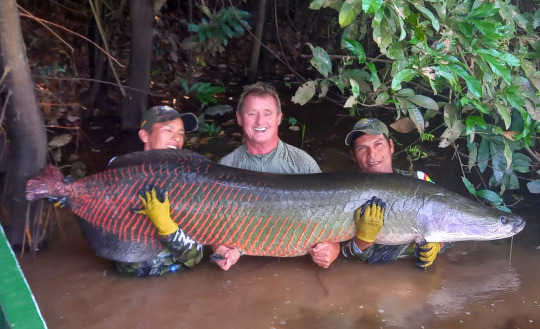
(image: several anglers with an arapaima)
Arapaimas are obligate air-breathers and will drown if they can't get to the surface to breathe. This is accomplished with a specialized swim bladder. The swim bladder is filled with highly vascularized tissue, letting it act like a lung. This pseudo-lung opens into the mouth using a modified gill arch known as the labyrinth organ. Arapaima gills are too small to sustain them, but they can supplement their oxygen intake with the gills. Juveniles are born exclusively using their gills and transition into air-breathers shortly after hatching. Arapaimas can survive up to a full day out of the water. They typically surface to gulp in air every 15-20 minutes. Breathing makes a loud gulping sound that anglers use to target them.
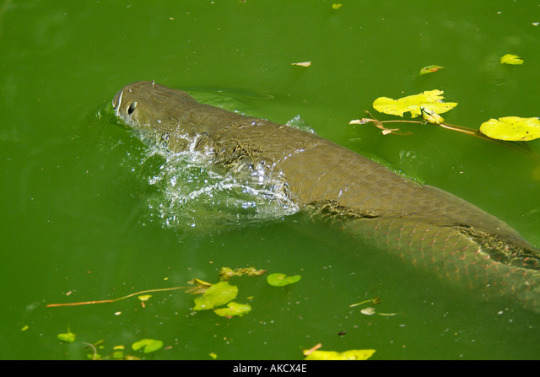
(image: an arapaima at the surface)
Because of their ability to breathe air, arapaimas are top predators in low-oxygen environments. Non-air breathing fish are forced to slow down in water with low levels of dissolved oxygen as they can't get enough oxygen through their gills. Since Arapaimas breathe air, they can easily chase down lethargic smaller fish. They are especially potent predators during the low season, when water levels lower. A combination of rotting vegetation reducing oxygen levels and ponds getting cut off from rivers and losing a supply of oxygen lets the arapaima reign supreme. Arapaimas are primarily predators that feed on smaller fish, though they will hunt other types of animals and eat fruits and seeds. Even land animals aren't safe as arapaimas have been known to launch themselves out of the water to catch animals near the shore. A combination of sharp teeth and their bony tongues are used to debilitate prey.
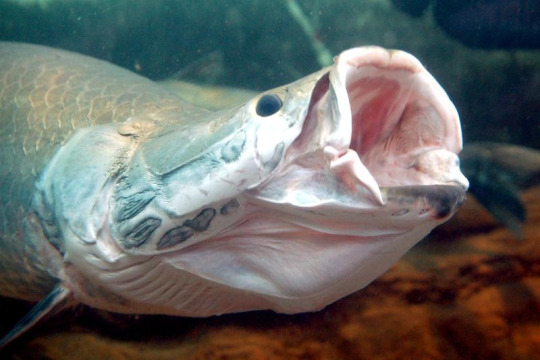
(image: an arapaima with its mouth open)
Not content with powerleveling their attack stat, arapaimas also have excellent defense. Their scales have been compared to bullet proof vests. Each has a hard, mineralized outer layer over multiple layers of collagen fibers. These layers are all oriented at an angle to each other to provide extra strength. This orientation of layers is called a Bouligand-type arrangement and is similar to how plywood is assembled. The harder outer layers and flexible inner layers work together to allow for both strength and flexibility. These scales help provide protection form large predators such as caiman and small threats like biting piranha. They also like provide protection from other arapaima, as the fish are aggressive and will fight each other.

(image: a diagram showing the composition of arapaima scales. source)
You probably wouldn't expect a swimming tank of an animal to be a good parent, but you'd be wrong. Arapaimas work together in mated pairs to build nests for their eggs, then cooperate to guard the nest. Once the eggs hatch, the male will practice mouth brooding, keeping his young safe in his mouth. The female will also help by patrolling the area around the male to ward off predators. They secrete pheromones from their heads to ensure the young don't swim too far away. Eggs are laid either in in the low season or as water levels are starting to rise, ensuring that the young become independent during the high season.
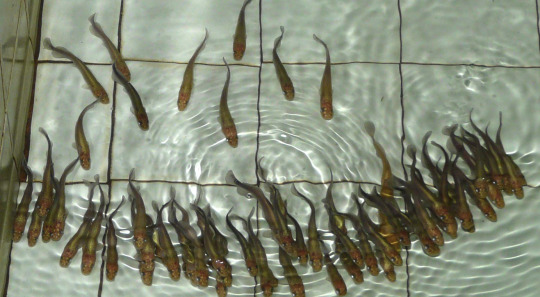
(Image: baby arapaimas)
Arapaima are classified as "data deficient" by the IUCN. This means there isn't enough data to properly assess their conservation needs. They are known to be threatened by overfishing. Arapaima make up a large part of the diet of many South American populations. Habitat loss and pollution are also believed to threaten them. They have been introduced to many areas out of their native range and are an invasive species in placed like Florida, Malaysia, and India.
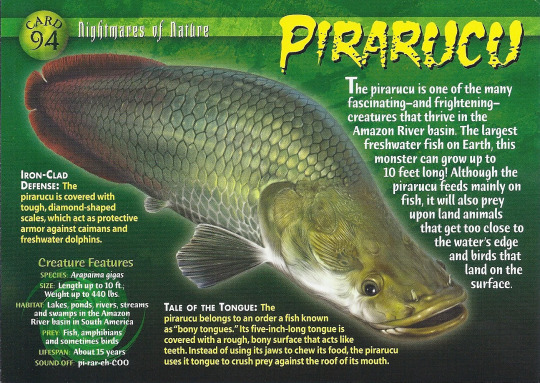
Does anyone else remember these cards? (image: the arapaima card from Weird n' Wild Creatures)
#wet beast wednesday#fishblr#fish#biology#zoology#ecology#animals#aquatic biology#animal facts#absolute unit#arapaima#pirarucu#paiche
1K notes
·
View notes
Text
this absolute icon

not only does she wear bright red lipstick she literally struts across the sea floor: red lipped batfish use their pectoral fins to 'walk' because they aren’t good swimmers.
#this is her world all of us just live in it#fish facts#fishblr#fish#marine animals#marine biology#marine life#aquatic life#red lipstick#red lipped batfish#deep sea creatures
298 notes
·
View notes
Note
You may have done this one already but would you be willing to do a cownose stingray or a beluga whale (i know whales are not fish so I completely understand if this is out of bounds)
Well, I do only make fish facts, but I can tell you off the top of my head that there are no beluga attacks on record at all! At least I recall it being that way. They’re friendly guys! :) Anyway, to that fish fact!
Daily fish fact #471
Cownose ray!

They get their name from the shape of their two-lobed head, which is the shape of a cow’s nose when viewed from above. They’re a social species, living in schools with up to 10 000 individuals!
#fish#fishfact#fish facts#fishblr#marine biology#marine life#marine animals#sea creatures#sea animals#sea life#biology#zoology#cownose ray#ray#rays#asks#anonymous asks#anon#anonymous#aquatic
671 notes
·
View notes
Text
DYK..

ghost sharks have long tapering bodies and incredibly large heads. their skin ranges in color from black to pale blue to brownish grey and is quite smooth. they have large eyes, oversized nostrils, and large, visible teeth, which give them a rabbit-like appearance, though within their mouths are three tooth plates.
ghost sharks have mineralized tooth plates. they use these teeth to crush mollusks and worms, making for an interesting diet.
ghost sharks primarily caught as bycatch. while their meat is edible, the majority of their commercial value comes from their livers, which contain an oil known as squalene that's used in a wide variety of cosmetic and pharmaceutical products.
#marine life#shark#sea creatures#sea#aquatic#sealife#marine biology#sharks#ocean#water#ghost shark#shark thoughts#shark posting#shark girl#shark speaks#shark week#sharks lb#facts#nature#animal#sea life#deep sea#marine animals#jellyfish#sea animals#deep sea facts#deep sea life#interesting facts#interesting stuff#interesting times
92 notes
·
View notes
Text
You know, the first time I heard about Vox having a shark named Vark, I thought "Oh that's kinda cute" and didn't really care. How quickly things change. Vark and the entirety of Vox's shark obsession is so important to me, bro has a whole aquarium of them in his meeting room. He's the main antagonist next season, so crossing my fingers we get Vark's name dropped at some point, I need it to be canon so bad
#theres also some irony in the fact mr tv tech man has a water wall to feed his obsession with an aquatic animal#hazbin hotel#vox#hazbin hotel vox
20 notes
·
View notes
Text
Did you know, that nudibranch’s (aka. Sea slugs) are hermaphrodites, which means that they have both male and female reproductive systems, meaning that when they find a mate, they inseminate each other at the same time; they do this by spearing each other with their genitalia.
Here is my favourite sea slug, the butterfly cyerce nudibranch, and they feed on algae:

#animal facts#animals#facts#random facts#aquatic#aquatic creatures#sea slug fact#sea slug facts#sea slugs#sea slug#butterfly sea slug#butterfly cyerce nudibranch
17 notes
·
View notes
Text

Nothosaurus: “I know I have the body but of a strong and swift reptile; but I have the heart and stomach of a fish!👑
🦎🌊
#history#nothosaurus#reptile#jurassic world#jw#camp cretaceous#prehistoric animals#extinct#fossils#paleontology#jurassic world camp cretaceous#jurassic park fan#plesiosaur#triassic#aquatic reptiles#extinct animals#prehistoric#nickys facts
115 notes
·
View notes
Note
can we talk about sharks not having bones 😦
Yes,yes we can ☺️.
Sharks don’t have bones(obv) but instead cartilage,which is lighter the actual bones,which allows a shark to be more buoyant.Which makes it much easier for them to swim,and it’s also much more dense,meaning sharks can swim without using to much energy, But despite not having bones sharks can still fossilize :)
and,sharks aren’t the only sea creatures without bones,any animal in the Chondrichthyes class have cartilage instead of bones.
thank you for coming to my ted talk

#sharks solo your favs 🤷♀️#sharks#sharks my beloved#shark thoughts#shark facts#marine animals#marine biology#marine life#sea creatures#sea life#aquatic#aquatic animals#aquatic life
40 notes
·
View notes
Text


earth fact time. this is a blue-banded goby! a lot of marine species can change their sex, but most can only change in one direction (e.g. the blackeye goby). blue-banded gobies can change back and forth, sometimes even within days!
oceana.org | fishbase
#aquatic#earthposting#facts!#fishblr#marine biology#marine life#marine animals#sea creatures#sea animals#sea life#biology#zoology#blue banded goby#catalina goby#lythrypnus dalli#earth fact no. 3
325 notes
·
View notes
Text
Easily my most popular post was about paddlefish, so this Wet Beast Wednesday it's time to give them their moment in the sun. Paddlefish are members of the family Polyodontidae and one of only two surviving members of the order Acipenseriformes, the other being sturgeons. The Acipenseriformes are one of the oldest lineages of ray-finned fish and diverged from the ancestors of all other modern ray-finned fish around 300 millions years ago. While paddlefish have been around since the Cretaceous period, there is only one living species, the American paddlefish (Polyodon spathula). Another modern species is the Chinese paddlefish (Psephurus gladius), but the last sighting of one was in 2003 and they were officially declared extinct in 2022. In this post, unless I specify otherwise everything I say will be referring to the American paddlefish.

(image: either an American paddlefish or a basking shark that got its nose caught in a hydraulic press)
Paddlefish are named for their very long rostrums which are packed full of electrorecepting organs called the ampullae of Lorenzini used to sense electric fiends in the water. The ampullae are not only on the rostrum, but also on the head and large skin flaps that extend from the operculum (gill cover). They are so sensitive that paddlefish are able to sense the movement of individual body parts of zooplankton. Paddlefish use their rostrums to detect their prey, which consists almost entirely of zooplankton. They are ream suspension feeders, swimming toward swarms of zooplankton with their mouths open. As the water passes through the gills, gill rakers filter out the zooplankton, which is then swallowed. Other fish that use this feeding method include basking sharks. While the rostrum is the primary method of prey detection, other ampullae on the head and operculum flap allow the fish to still effectively find food even if the rostrum is damaged or destroyed. When working fish fish on the Mississippi I caught multiple paddlefish who lost their rostrums to propeller strikes and were still doing fine. Electroreception is their main sense, with their eyesight being extremely poor.

(image: the skeletal structure of the rostrum)
As chordates, paddlefish have a notochord that runs from the head down the body. In most modern chordates, the notochord is only present in the embryo and is lost during development. This is not the case for paddlefish, who retain their notochord into adulthood, where is acts as a soft spine. While paddlefish (and their sturgeon cousins) are bony fish, they have lost most of the bone and now have skeletons composed almost entirely of cartilage. It is for this reason that early taxonomists initially miscategorized paddlefish as freshwater sharks. To be fair, they do look a lot like miniature basking sharks. Who crossbred with spoons. They also lost their scales and have smooth, easily damaged skin instead. Their skin is so easily damaged that just being caught in nets can leave scars. Paddlefish are large and long-lived. The American species reaches an average of 1.5 m (5 ft) in length, with the rostrum making up a third of that, and a weight of 27 kg (60 lbs). The largest recorded specimen was 2.16 m (7 ft 1 in) and an estimated 90 kg (198 lbs). Despite being one of the largest American freshwater fish, they paled in comparison to the Chinese species, which could reach 3 m (9.8 ft) and 500 kg (1,100 lbs). The largest Chinese paddlefish on record was 7 m (23 ft) long and was estimated to weigh "a few thousand pounds". The Chinese paddlefish also preferred larger prey, feeding largely on small fish and crustaceans. American paddlefish live an average of 5 to 8 years, but in the right circumstances can live up to 60 years, with females generally living longer. The Chinese paddlefish had an estimated average lifespan of 29-38 years. In both species, it is believed that human activity drastically reduced their average lifespans.
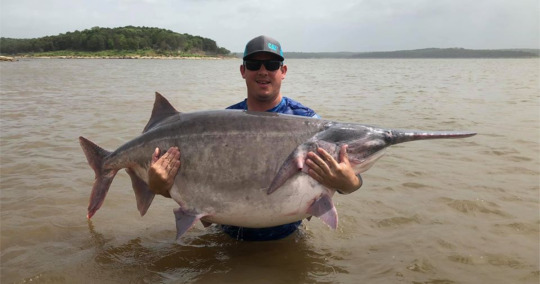
(image: an absolute unit of an American paddlefish)
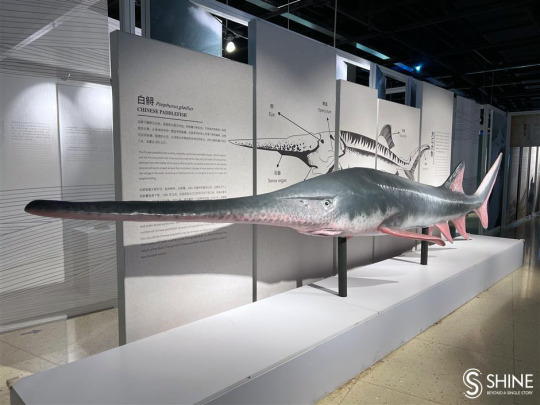
(image: a reconstruction of a Chinese paddlefish from the Shanghai Science and Technology Museum)
Paddlefish travel upriver to spawn in spring. They prefer to span on shallow gravel bars that would be exposed to air if not for spring rainfall and snow melt. Because they require very specific conditions to spawn, spawning rarely occurs every year. Every 4-5 years is more common. Paddlefish are broadcast spawners, with both males and females releasing gametes into the water column. Fertilized eggs are negatively buoyant and sticky. They will sink to the bottom and stick to the gravel. Once hatched, larvae will be swept down river to develop in deep pools. They are born without rostrums, which start to grow almost immediately. Paddlefish mature late, with females becoming sexually mature between 7 and 10 years of age, with a few not maturing until as late as 16-18 years. Human activity is resulting in many individuals dying before becoming sexually mature. American paddlefish are cross-fertile with the Russian sturgeon (Acipenser gueldenstaedtii), producing a hybrid offspring known as the sturddlefish despite being separated by the Atlantic ocean and 184 million years of evolution. This was discovered by accident when scientists introduced paddlefish sperm too sturgeon eggs as a control group for an experiment. I made a post on the sturddlefish which you can read here.

(image: three larval paddlefish of different ages)
American paddlefish are classified as vulnerable by the IUCN. They are native to the Mississippi river basin that encompasses much of the midwest and south of the United States, but their range used to be larger, reaching into Lake Huron, the Northeastern U.S. and parts of Canada. This reduction of native range is due largely to human activity, mostly overfishing and habitat loss. Zebra mussels, an invasive species, are a major competition for paddlefish as theybith feed on zooplankton. Reintroduction programs have begun in some of the states they were extirpated from, and they have been introduced to China, Cuba, and multiple countries in Europe for use in fishing and caviar production. 13 states allow for sport fishing of paddlefish, some of them relying on restocking to maintain a population for anglers. Paddlefish meat is edible and their eggs can be used for caviar. Paddlefish can be raised in captivity, but must will not spawn in captivity and so establishing captive populations requires gonad extraction and artificial insemination. Poaching of wild paddlefish for their eggs is an ongoing problem. The extinction of the Chinese paddlefish is believed to be the result of overexploitation and habitat loss.
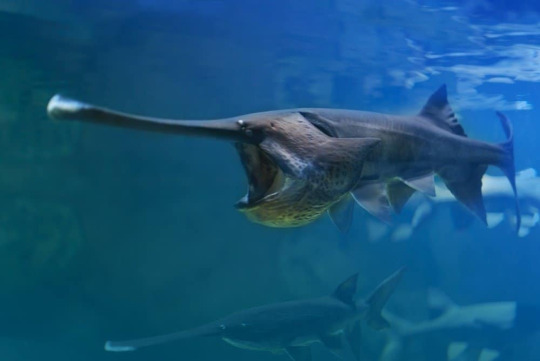
(image: a paddlefish with its mouth open)
#wet beast wednesday#biology#zoology#fish#ecology#fishblr#freshwater biology#freshwater fish#aquatic biology#paddlefish#american paddlefish#chinese paddlefish#animal facts
518 notes
·
View notes
Text

There is a black sheep in ever family (or genus).
Behold, the marine iguana (Amblyrhynchus cristatus).
This lizard inhabits the Galapagos Islands and grows to around 0.6 (female) to 1.3 m long (male). They have a very unusual diet compared to their mainland counterparts: marine algae.
In order to get at their favorite food these animals have become the only lizards to dive in saltwater, they can hold their breath for 30-40 minutes at a time and use an undulating body movement to push themselves through the water.
Feeding in this environment presents some unique challenges for a endothermic creature, after feeding underwater the iguanas must sunbathe on the dark volcanic rocks that make up the shore of the islands to regain the heat to create energy. They also spit excess salt of their nasal glands with surprising force, sending wads of salty discharge quite high in the air.
The also tend to sunbathe in large groups so vast clusters of these large, sneezing, punk-rock aesthetic animals are not a rare sight on the shores of the Galapagos Islands.
#marine biology#marine life#marine animals#ocean animals#marine zoology#ocean#oceanlife#ocean life#sea creatures#lizard#squamatine#reptile#chordata#wet beast wednesday#aquatic animals#sea animals#animal facts#animalia#aquatic
23 notes
·
View notes
Text
Daily fish fact #218
Whale shark!

Whale sharks have over 300 rows of tiny teeth! They don't use these teeth for anything, as these sharks are filter feeders. A whale sharks' mouth is also at the very front of its head, which is unusual for sharks!
#fish#fishfact#fish facts#biology#zoology#aquatic#fishblr#marine biology#marine life#sharks#sea life#sea creatures#marine animals#whale shark#aquatic life
625 notes
·
View notes
Text
DYK…

tiger sharks are non-selective feeders and a voracious predator. they has been known to consume a wide variety of marine prey and even some terrestrial animals. common prey include crabs, shellfish, lobsters, squid, bony fish, small sharks, skates, rays, porpoises, turtles, marine birds and mammals.
tiger sharks are apex predators meaning they don't have many natural predators. in fact one of the only known predators to this species are humans and killer whales. a killer whale is much larger in size and weight, which allows it to overpower the shark.
tiger sharks are named for the dark, vertical stripes found mainly on juveniles. as these sharks mature, the lines begin to fade and almost disappear.
#marine life#sea creatures#sharks#shark#marine biology#ocean#sea#aquatic#sealife#water#tiger sharks#tiger shark#save the sharks#shark week#fun facts#shark facts#nature#marine animals#animals#wildlife#i love sharks (and getou’s balls)
124 notes
·
View notes
Text
DAILY DOSE OF SHARK JOKES
What did the shark get when it travelled to the Arctic Ocean?
Frostbite.

Okay but for real, let’s talk about the Greenland Shark that does inhabit the Arctic and North Atlantic Oceans.
Did you know that Greenland Sharks are estimated to live up to 250 years?
Well, if not, you learn something new everyday! Greenland Sharks may also live up to over 500 years and these are the sharks with the longest lifespan. But, even if Scientists have noticed that Greenland Sharks live for long periods of time, they didn’t have a way to specify how long.
That’ll be all for a daily dose of Aquatic Life! Go take a bite out of life! (that line was like the first thing i saw ik it’s cheesy asf)
#sharks#animal facts#live laugh love#livelaughlovesharks#writing#aquablr#aquatic#aquatic life#corny asf
19 notes
·
View notes